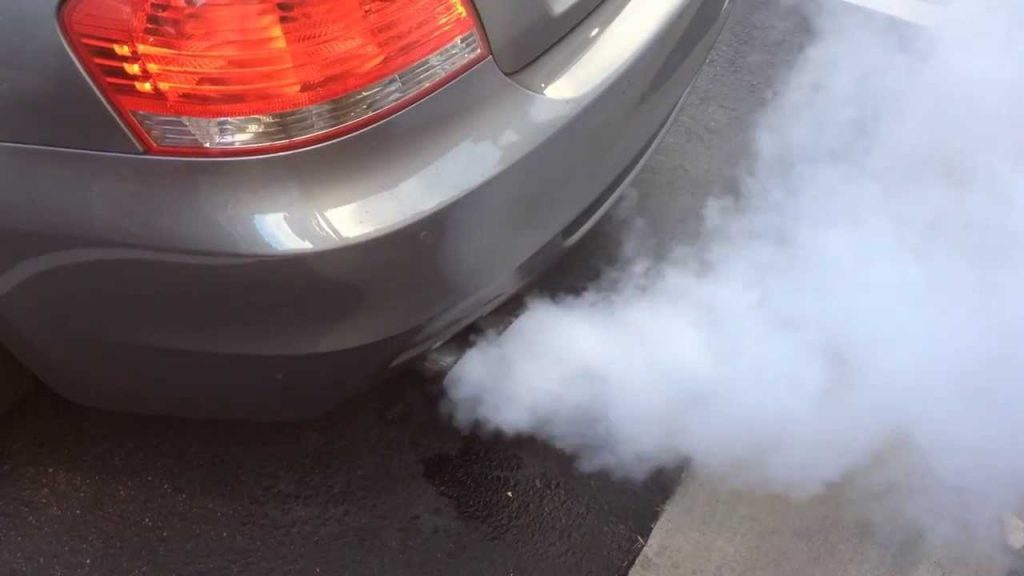As a result of the combustion of fuel in the cylinders of the car engine, exhaust gases enter the exhaust system – in the normal state of the exhaust system, the gases have a barely noticeable color and quickly dissipate into the air.
However, if the smoke differs from the norm, this indicates a malfunction of the engine or fuel system. Black (also blue) smoke indicates the presence of oil or a very small amount of air in the combustible mixture. White smoke may also indicate this. But in general, if you approach the diagnosis of the engine as meticulously as possible, then any smoke from the exhaust pipe indicates problems. Ideally, the smoke should be colorless, which means that there are no impurities in the fuel, and the entire engine group is working correctly.
If such a sign is detected, it is necessary to refrain from using the car and, if possible, carry out a complete diagnosis of the engine, since the color of the exhaust may indicate a serious problem in the operation of the power unit in the most direct way. Timely diagnostics will eliminate all engine problems and significantly increase the period of its effective operation.
In addition, there are indirect signs of the presence of oil in the fuel mixture, which should also be treated with all seriousness. These include: poor engine performance in the main modes, poor traction, increased fuel consumption. All this is a serious reason to diagnose the engine, if you do not pay attention to these problems, you can get into big trouble, for example, an engine overhaul. And it’s not cheap at all, and besides, it takes quite a long time.
As mentioned above, the exhaust may also have white smoke. However, if this only manifests itself in cold weather and on an unheated engine, that is, for a short time, then you should not worry too much. This can evaporate condensate, which takes place if into the exhaust pipe (but not into the engine itself!) water got in. But if you notice white smoke from the exhaust system in warm and dry weather, or when the engine has been running for some time and has warmed up well, this is a serious reason to think, since such smoke may indicate that coolant has entered the fuel mixture. And this, in turn, can lead to very serious problems, for example, a water hammer in the engine. The consequences of this problem can be the most deplorable.
It is quite simple to diagnose the ingress of coolant into the fuel system, this will require a partner and a few minutes of free time. The first step is to remove the lid of the coolant tank, then ask your partner to start the engine. After starting the engine, put your hand to the neck of the expansion tank and check whether the pressure in the cooling system is increasing. If so, there is every reason to suspect that coolant has entered the cylinders. Also, if the system is not sealed, then an obvious odor will come from the expansion tank, indicating that exhaust gases have entered it.
All this indicates a possible burnout of the cylinder block gasket, or, even worse, the presence of a crack in the cylinder block. Any of these signs is a reason to think about the early diagnosis of the engine. Careless attitude to the analysis of these signs can lead to a complete failure of the engine, which will entail expensive repairs. It is clear that it is not worth putting off for a day.
All of the above applies to gasoline engines. In the case of diesel engines, the situation is slightly different – black smoke can be noticed there too, however, it will not indicate moisture entering the cylinders, but over-enrichment of fuel. In most cases, it is necessary to check components such as the high-pressure fuel pump (injection pump) and injectors. But do not forget that the air filter should also be checked, since if it is clogged, it will not be able to pass through itself a large amount of air necessary to create the right fuel mixture.
Blue smoke, just like in gasoline engines, may indicate that lubricating oil has entered the cylinders. However, due to the presence of design differences between engines running on different fuels, the problem may also lie in the injection pump. For example, late fuel injection, or a clogged fuel filter can also contribute to the appearance of blue smoke from the exhaust pipe when the car engine is running. In addition, diesel engines are more often equipped with turbines, especially for trucks. A malfunction of this unit can also lead to the appearance of dark smoke from the exhaust pipe. For example, the wear of turbine bearings contributes to the ingress of engine oil into the engine cylinders, which will inevitably lead to increased consumption and a decrease in engine life.
However, on diesel engines, with some problems, not only bluish smoke may appear, but also white. The reason for this is the same factor as described above regarding gasoline engines — this is the ingress of coolant into the engine cylinders. However, due to the design features of diesel engines, there are more places from where the coolant can enter the unit. For example, these are intake manifolds – on diesels they are heated with the help of coolant, and the burning of the gasket or its complete wear leads to liquid entering the engine. As a result, a very high probability of the appearance of a characteristic white exhaust can be expected.
But due to their inexperience, many motorists may confuse white smoke with steam. But the smells of steam and smoke are completely different, and if you sniff, it is very difficult to confuse them. If the coolant enters the exhaust system, the exhaust not only turns white, but also acquires a characteristic sweet smell, which is easy to feel if you sniff the exhaust fumes thoroughly.
You can also use a simple white sheet of paper as a diagnostic. It is worth bringing a sheet to the exhaust pipe and letting the engine work a little. In the case of steam, the sheet will just get a little wet. If there is oil or coolant trapped in the fuel mixture, then characteristic oily or other technical stains will appear on the paper very quickly.
Avaruosad.ee – online auto parts store
Need spare parts for your car? Call for free consultation:
- +372 56 812 812
- info@avaruosad.ee


